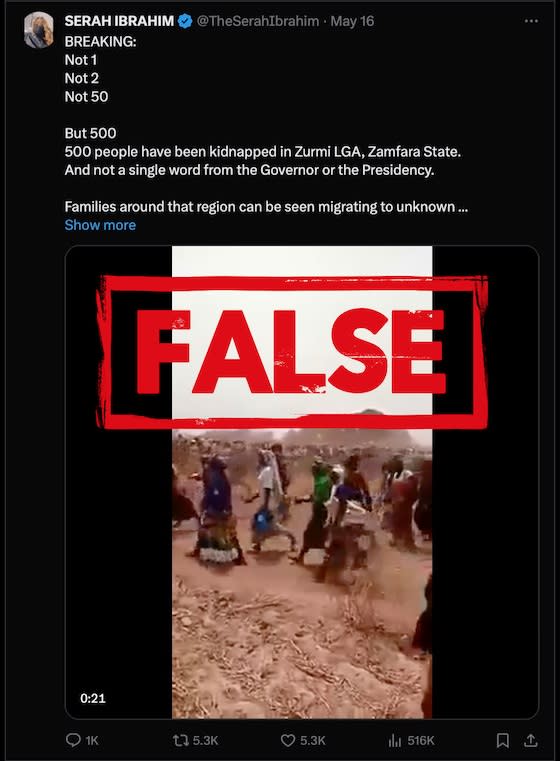Post falsely claims old video shows Nigerians fleeing kidnapping gangs
Viral disinformation about rampant kidnap-for-ransom rackets in Nigeria led to a recent claim about a video purportedly showing villagers fleeing their homes after gunmen kidnapped 500 people in Zamfara state in the country's northwest. But the claim is false: the video – previously debunked by AFP Fact Check – is old and was taken in Burkina Faso. A police spokesman in Zamfara did not immediately respond to AFP Fact Check’s request for comment.
“500 people have been kidnapped in Zurmi LGA, Zamfara State. And not a single word from the Governor or the Presidency. Families around that region can be seen migrating to unknown destinations, in an attempt to run away from the attackers,” reads a post shared on X on May 16, 2024.

Zurmi, mentioned in the claim, is a town in Zamfara state in northwest Nigeria.
Zamfara state has been one of the hardest hit by the prolific kidnappings in Nigeria’s north.
Published by an opposition supporter called “Serah Ibrahim”, the post features a 30-second clip of people walking briskly over dusty ground.
Other X accounts (here and here) repeated the claim.
Weeks before the allegation surfaced, gunmen attacked the town and attempted to kidnap its emir (archived here). The assailants destroyed electricity and telecommunication facilities after their kidnapping attempt failed.
In December 2023, international aid group Médecins Sans Frontières (MSF) temporarily withdrew some of its staff from the town after fighting around the local hospital had escalated (archived here).
Two months earlier, the Nigerian military said about 100 gunmen were killed in the state (archived here).
The gangs, notorious for mass kidnappings from schools and colleges in recent years, maintain camps hidden in a vast forest straddling Zamfara, Katsina, Kaduna, and Niger states.
But the claim that the video showed people fleeing Zurmi after 500 people were kidnapped is false.
Burkina Faso
To verify the claim, AFP Fact Check took a screenshot of the misleading video and carried out a reverse image search.
We found that the video has been online since 2021.
Germany-based charity organisation SAIDA International shared a longer version of the clip on its Facebook page on June 8, 2021 (archived here).
The caption, written in German, explained that the footage showed “the people of Burkina Faso” on the run “in their own country”.
It also included the hashtag #solhan, which suggested that the video showed residents of Solhan, a town close to Burkina Faso’s border with Niger and Mali.
A Burkina Faso news outlet, Lobs Paalga, published another version of the video on its YouTube channel the same day as SAIDA (archived here). It said the clip showed “inhabitants of Solhan” fleeing their town.
UNICEF said 130 people, many of them children, were killed in the town on June 5, 2021, by a “non-state armed group” (archived here) allegedly comprising children (archived here).
AFP covered the incident and put the number of dead at more than 130 (archived here). It said at least 7,000 people fled Solhan after the bloodiest massacre in Burkina Faso’s six-year-old jihadist insurgency at the time.
The footage is repeatedly used to mislead the public about Nigeria’s security challenges. AFP Fact Check debunked the video in April 2022 when it was similarly used out of context.
At the time, an AFP reporter in Burkina Faso’s capital Ouagadougou said the language spoken in the video is Moore, common to parts of Burkina Faso but not spoken in Nigeria.
The spokesman for the police in Zamfara, Yazid Abubakar, did not immediately reply to AFP's request for comment.
Burkina Faso’s insurgency
Like Nigeria, Burkina Faso has been grappling with a violent insurgency since 2015, largely fuelled by jihadist groups linked to Al-Aaeda and the Islamic State (archived here).
These groups have exploited ethnic tensions, weak state presence, and local grievances to expand their influence, particularly in the northern and eastern regions.
So far, the conflict has forced over two million people to flee their homes (archived here).
Humanitarian conditions have also deteriorated sharply, with many facing acute food insecurity and limited access to basic services.
